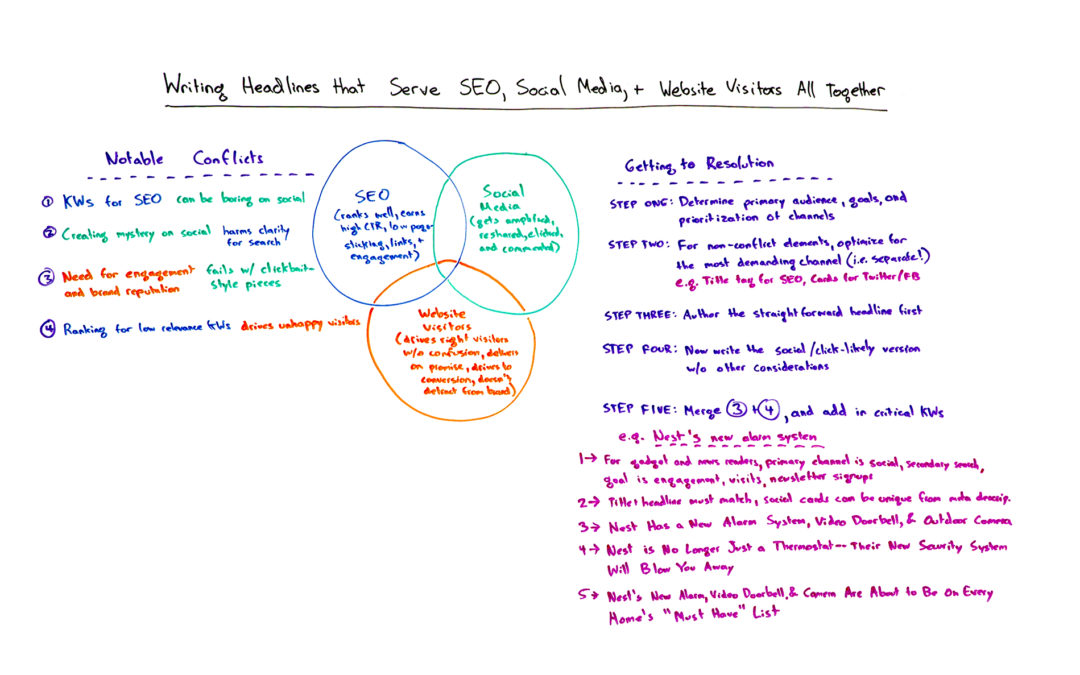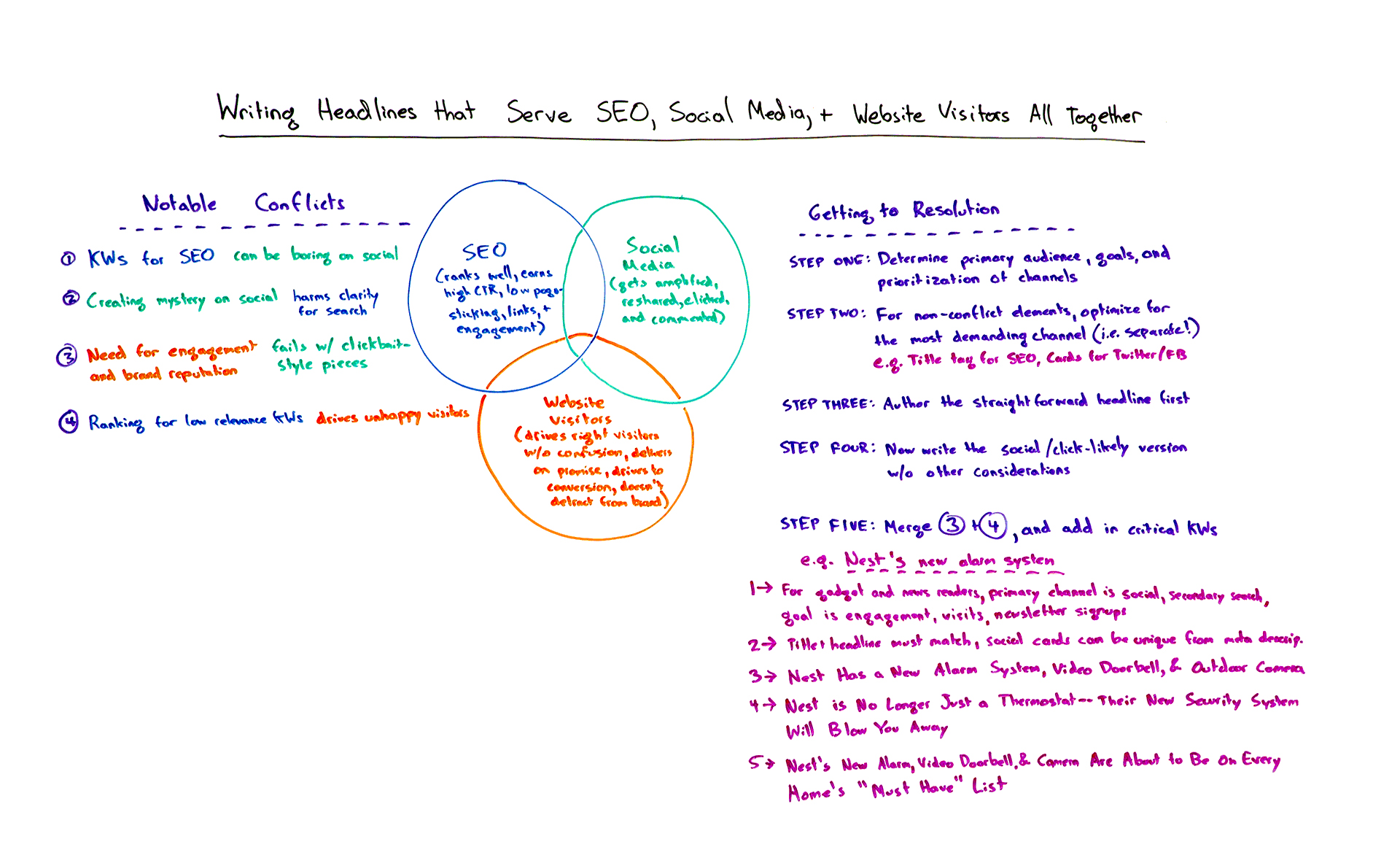Posted by randfish
Have your headlines been doing some heavy lifting? If you’ve been using one headline to serve multiple audiences, you’re missing out on some key optimization opportunities. In today’s Whiteboard Friday, Rand gives you a process for writing headlines for SEO, for social media, and for your website visitors — each custom-tailored to its audience and optimized to meet different goals.
Click on the whiteboard image above to open a high-resolution version in a new tab!
Video Transcription
Howdy, Moz fans, and welcome to another edition of Whiteboard Friday. This week we’re going to chat about writing headlines. One of the big problems that headlines have is that they need to serve multiple audiences. So it’s not just ranking and search engines. Even if it was, the issue is that we need to do well on social media. We need to serve our website visitors well in order to rank in the search engines. So this gets very challenging.

I’ve tried to illustrate this with a Venn diagram here. So you can see, basically…
SEO
In the SEO world of headline writing, what I’m trying to do is rank well, earn high click-through rate, because I want a lot of those visitors to the search results to choose my result, not somebody else’s. I want low pogo-sticking. I don’t want anyone clicking the back button and choosing someone else’s result because I didn’t fulfill their needs. I need to earn links, and I’ve got to have engagement.
Social media
On the social media side, it’s pretty different actually. I’m trying to earn amplification, which can often mean the headline tells as much of the story as possible. Even if you don’t read the piece, you amplify it, you retweet it, and you re-share it. I’m looking for clicks, and I’m looking for comments and engagement on the post. I’m not necessarily too worried about that back button and the selection of another item. In fact, time on site might not even be a concern at all.
Website visitors
For website visitors, both of these are channels that drive traffic. But for the site itself, I’m trying to drive right visitors, the ones who are going to be loyal, who are going to come back, hopefully who are going to convert. I want to not confuse anyone. I want to deliver on my promise so that I don’t create a bad brand reputation and detract from people wanting to click on me in the future. For those of you have visited a site like Forbes or maybe even a BuzzFeed and you have an association of, “Oh, man, this is going to be that clickbait stuff. I don’t want to click on their stuff. I’m going to choose somebody else in the results instead of this brand that I remember having a bad experience with.”
Notable conflicts
There are some notable direct conflicts in here.
- Keywords for SEO can be really boring on social media sites. When you try and keyword stuff especially or be keyword-heavy, your social performance tends to go terribly.
- Creating mystery on social, so essentially not saying what the piece is truly about, but just creating an inkling of what it might be about harms the clarity that you need for search in order to rank well and in order to drive those clicks from a search engine. It also hurts your ability generally to do keyword targeting.
- The need for engagement and brand reputation that you’ve got for your website visitors is really going to hurt you if you’re trying to develop those clickbait-style pieces that do so well on social.
- In search, ranking for low-relevance keywords is going to drive very unhappy visitors, people who don’t care that just because you happen to rank for this doesn’t necessarily mean that you should, because you didn’t serve the visitor intent with the actual content.
Getting to resolution
So how do we resolve this? Well, it’s not actually a terribly hard process. In 2017 and beyond, what’s nice is that search engines and social and visitors all have enough shared stuff that, most of the time, we can get to a good, happy resolution.
Step one: Determine who your primary audience is, your primary goals, and some prioritization of those channels.
You might say, “Hey, this piece is really targeted at search. If it does well on social, that’s fine, but this is going to be our primary traffic driver.” Or you might say, “This is really for internal website visitors who are browsing around our site. If it happens to drive some traffic from search or social, well that’s fine, but that’s not our intent.”
Step two: For non-conflict elements, optimize for the most demanding channel.
For those non-conflicting elements, so this could be the page title that you use for SEO, it doesn’t always have to perfectly match the headline. If it’s a not-even-close match, that’s a real problem, but an imperfect match can still be okay.
So what’s nice in social is you have things like Twitter cards and the Facebook markup, graph markup. That Open Graph markup means that you can have slightly different content there than what you might be using for your snippet, your meta description in search engines. So you can separate those out or choose to keep those distinct, and that can help you as well.
Step three: Author the straightforward headline first.
I’m going to ask you author the most straightforward version of the headline first.
Step four: Now write the social-friendly/click-likely version without other considerations.
Is to write the opposite of that, the most social-friendly or click-likely/click-worthy version. It doesn’t necessarily have to worry about keywords. It doesn’t have to worry about accuracy or telling the whole story without any of these other considerations.
Step five: Merge 3 & 4, and add in critical keywords.
We’re going to take three and four and just merge them into something that will work for both, that compromises in the right way, compromises based on your primary audience, your primary goals, and then add in the critical keywords that you’re going to need.
Examples:
I’ve tried to illustrate this a bit with an example. Nest, which Google bought them years ago and then they became part of the Alphabet Corporation that Google evolved into. So Nest is separately owned by Alphabet, Google’s parent company. Nest came out with this new alarm system. In fact, the day we’re filming this Whiteboard Friday, they came out with a new alarm system. So they’re no longer just a provider of thermostats inside of houses. They now have something else.
Step one: So if I’m a tech news site and I’m writing about this, I know that I’m trying to target gadget and news readers. My primary channel is going to be social first, but secondarily search engines. The goal that I’m trying to reach, that’s engagement followed by visits and then hopefully some newsletter sign-ups to my tech site.
Step two: My title and headline in this case probably need to match very closely. So the social callouts, the social cards and the Open Graph, that can be unique from the meta description if need be or from the search snippet if need be.
Step three: I’m going to do step three, author the straightforward headline. That for me is going to be “Nest Has a New Alarm System, Video Doorbell, and Outdoor Camera.” A little boring, probably not going to tremendously well on social, but it probably would do decently well in search.
Step four: My social click-likely version is going to be something more like “Nest is No Longer Just a Thermostat. Their New Security System Will Blow You Away.” That’s not the best headline in the universe, but I’m not a great headline writer. However, you get the idea. This is the click-likely social version, the one that you see the headline and you go, “Ooh, they have a new security system. I wonder what’s involved in that.” You create some mystery. You don’t know that it includes a video doorbell, an outdoor camera, and an alarm. You just hear, “They’ve got a new security system. Well, I better look at it.”
Step five: Then I can try and compromise and say, “Hey, I know that I need to have video doorbell, camera, alarm, and Nest.” Those are my keywords. Those are the important ones. That’s what people are going to be searching for around this announcement, so I’ve got to have them in there. I want to have them close to the front. So “Nest’s New Alarm, Video Doorbell and Camera Are About to Be on Every Home’s Must-Have List.” All right, resolved in there.
So this process of writing headlines to serve these multiple different, sometimes competing priorities is totally possible with nearly everything you’re going to do in SEO and social and for your website visitors. This resolution process is something hopefully you can leverage to get better results.
All right, everyone, we’ll see you again next week for another edition of Whiteboard Friday. Take care.
Video transcription by Speechpad.com
Sign up for The Moz Top 10, a semimonthly mailer updating you on the top ten hottest pieces of SEO news, tips, and rad links uncovered by the Moz team. Think of it as your exclusive digest of stuff you don’t have time to hunt down but want to read!
![]()


